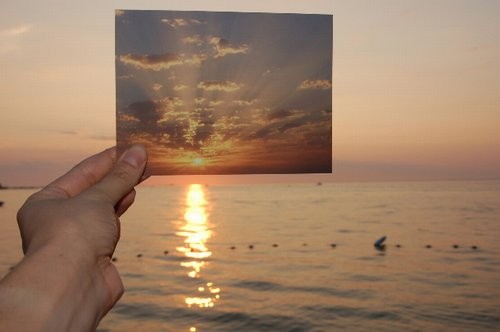Free
20 Oct 2010 - 23 Jan 2011

The Sun is Always Setting Somewhere Else, 2006
35mm slide projection. Courtesy of the artist.
20 October 2010 - 23 January 2011
Today, culture is more dispersed than ever before. The web has broadened both the quantity and kind of information freely available. It has distributed our collective experience across geographic locations; opened up a new set of creative possibilities; and, coextensively, produced a set of challenges. This fall, the New Museum will present “Free,” an exhibition including twenty-three artists working across mediums—including video, installation, sculpture, photography, the internet, and sound —that reflects artistic strategies that have emerged in a radically democratized landscape redefined by the impact of the web. The exhibition makes a case for a newly formed public art that responds to a vastly more connected society whose true openness is still being negotiated. The philosophy of free culture, and its advocacy for open sharing, informs the exhibition, but is not its subject. Instead, the title and featured works present a complex picture of the new freedoms and constraints that underlie our expanded public space. “Free” is curated by Lauren Cornell, Executive Director of Rhizome and New Museum Adjunct Curator.
“Free” is inspired in part by “Dispersion” (2001–), an essay by the artist Seth Price that is available as a free online booklet and will be featured within the exhibition as a large-scale sculptural installation composed of nine panels each imprinted with a page from the original booklet. The essay traces the increased dispersion of culture, by examining how its circulation and reception has changed across mediums from print, to video, and to the web. In light of the way we now experience political events and pop culture, Price questions the viability of public art as we understand it. Price writes: “We should recognize that collective experience is now based on simultaneous private experiences, distributed across the field of media culture, knit together by ongoing debate, publicity, promotion, and discussion. Publicness today has as much to do with sites of production and reproduction as it does with any supposed physical commons, so a popular album could be regarded as a more successful instance of public art than a monument tucked away in an urban plaza.” The works in “Free” alight from Price’s statements to demonstrate and explore the multiple ways artists utilize, appropriate, and reenact material sourced from a distributed public space.
For Lisa Oppenheim’s 35mm slideshow projection The Sun is Always Setting Somewhere Else (2006), the artist sourced from Flickr snapshots of sunsets taken by US soldiers based in Iraq, and re-photographed the soldiers’ photos against her own horizon in America, framing a common tendency to connect to a universal experience from a foreign vantage point. Artist Aleksandra Domanovic instigates a process of cultural transubstantiation in her work 19:30 (2010)—for which she traveled around the former Yugoslavia collecting visual introductions of nightly news shows from national television stations. She then uploaded these clips online and encouraged DJs to use them as the basis for new techno tracks—a genre of music chosen because it is based on the creation of infinite variations of original productions. Exhibited within the gallery as a two-screen video installation, 19:30 creates an unusual national archive while demonstrating how flexible the meaning of media can be, by revealing how easily obsolete culture from this former country (the nightly news sequences) can be rejuvenated into something vital with a shift in context.
Other works in the exhibition explore strategies around the appropriation of digital imagery. Take No Photographs, Leave Only Ripples (2009) by Clunie Reid is comprised of a series of found images the artist layers with hand-drawn anarchic expressions. Dark Current (2010), a series of photographs by Andrea Longacre-White, explores the aesthetics of photographic degradation, through images that the artist re-photographed countless times. Takeshi Murata, in a premiere single-screen video, explores the way public images are interpreted, transformed, and personalized as they cycle through different contexts and hands. For this new video, Murata used the 3d modeling program Cinema 4D to investigate the notion of knockoffs through Popeye, a popular character that has been endlessly remixed online and whose copyright in Europe recently expired. Artist Trevor Paglen investigates information—be it personal, scientific, or governmental data—that is masked from public view. In his new series of large-scale landscape photographs, Paglen reveals classified information: federally sanctioned eavesdropping facilities deep in West Virginia and the orbits of dead spy satellites around the moon—all secret activity made visible with extensive research and a long-range lens. Martijn Hendriks considers common forms of mass communication in his Untitled (Black Video) (2009). Hendriks sourced anonymous comments from an online video forum who participants were responding to the leaked video of the execution of Saddam Hussein: some crude, some unsettled, some laissez-faire, all demonstrating the kind of freedom associated with being unidentifiable. Artist Joel Holmberg asked searching, existential questions in the user-generated forum Yahoo Answers, like ‘How does it feel to be in love?’ or ‘How do I best convince someone I am an artist,’ in substitution of the mundane questions usually asked about pets or parking needs. Holmberg’s performance Legendary Account (2007-10) turns Yahoo Answers against itself by asking profound questions, instead of easily answerable ones.
Artists featured in “Free” include Liz Deschenes, Aleksandra Domanovic, Lizzie Fitch, Martijn Hendriks, Joel Holmberg, David Horvitz, Lars Laumann, Andrea Longacre-White, Kristin Lucas, Jill Magid, Hanne Mugaas, Takeshi Murata, Rashaad Newsome, Lisa Oppenheim, Trevor Paglen, Seth Price, Jon Rafman, Clunie Reid, Amanda Ross-Ho, Alexandre Singh, Ryan Trecartin & David Karp, and Harm Van Den Dorpel.
The exhibition catalogue will take the form of a frequently updated web site edited by Ceci Moss, Rhizome Senior Editor, with contributions by Lauren Cornell and guest essayists including author and critic Ed Halter; blogger Joanne McNeil; critic Brian Droitcour; and entrepreneur Caterina Fake, as well as related videos, articles, and artworks.
